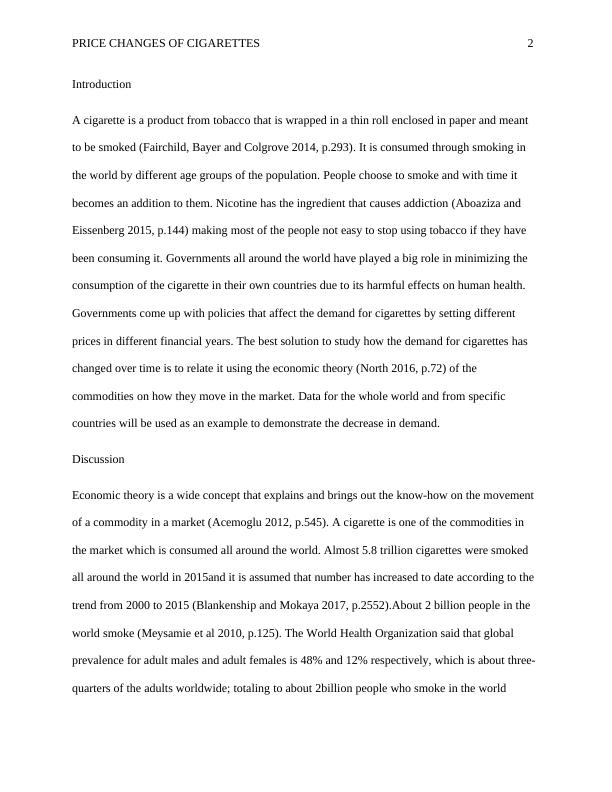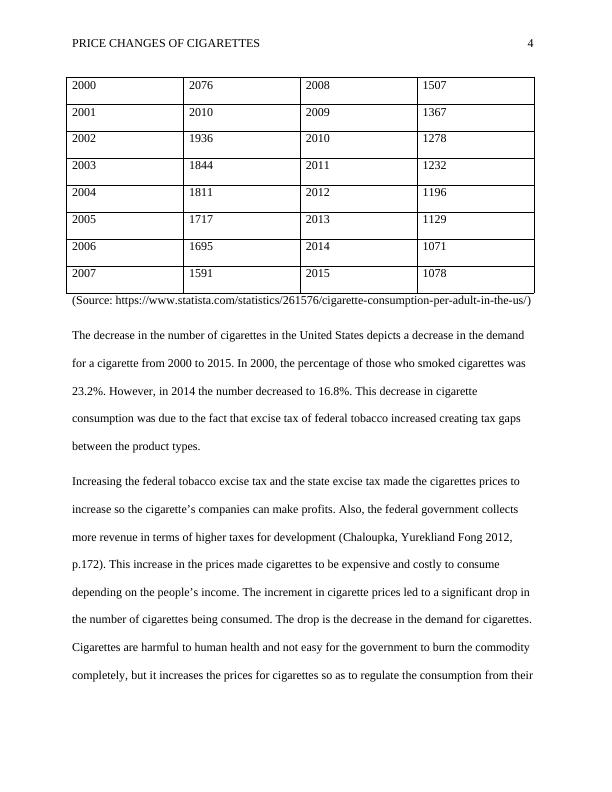Price Changes of Cigarettes
Added on 2023-01-23
11 Pages3053 Words33 Views
PRICE CHANGES OF CIGARETTES 1
ECONOMICS ASSIGNMENT
Student Name
Institutional Affiliation
Facilitator
Course
Date
ECONOMICS ASSIGNMENT
Student Name
Institutional Affiliation
Facilitator
Course
Date

PRICE CHANGES OF CIGARETTES 2
Introduction
A cigarette is a product from tobacco that is wrapped in a thin roll enclosed in paper and meant
to be smoked (Fairchild, Bayer and Colgrove 2014, p.293). It is consumed through smoking in
the world by different age groups of the population. People choose to smoke and with time it
becomes an addition to them. Nicotine has the ingredient that causes addiction (Aboaziza and
Eissenberg 2015, p.144) making most of the people not easy to stop using tobacco if they have
been consuming it. Governments all around the world have played a big role in minimizing the
consumption of the cigarette in their own countries due to its harmful effects on human health.
Governments come up with policies that affect the demand for cigarettes by setting different
prices in different financial years. The best solution to study how the demand for cigarettes has
changed over time is to relate it using the economic theory (North 2016, p.72) of the
commodities on how they move in the market. Data for the whole world and from specific
countries will be used as an example to demonstrate the decrease in demand.
Discussion
Economic theory is a wide concept that explains and brings out the know-how on the movement
of a commodity in a market (Acemoglu 2012, p.545). A cigarette is one of the commodities in
the market which is consumed all around the world. Almost 5.8 trillion cigarettes were smoked
all around the world in 2015and it is assumed that number has increased to date according to the
trend from 2000 to 2015 (Blankenship and Mokaya 2017, p.2552).About 2 billion people in the
world smoke (Meysamie et al 2010, p.125). The World Health Organization said that global
prevalence for adult males and adult females is 48% and 12% respectively, which is about three-
quarters of the adults worldwide; totaling to about 2billion people who smoke in the world
Introduction
A cigarette is a product from tobacco that is wrapped in a thin roll enclosed in paper and meant
to be smoked (Fairchild, Bayer and Colgrove 2014, p.293). It is consumed through smoking in
the world by different age groups of the population. People choose to smoke and with time it
becomes an addition to them. Nicotine has the ingredient that causes addiction (Aboaziza and
Eissenberg 2015, p.144) making most of the people not easy to stop using tobacco if they have
been consuming it. Governments all around the world have played a big role in minimizing the
consumption of the cigarette in their own countries due to its harmful effects on human health.
Governments come up with policies that affect the demand for cigarettes by setting different
prices in different financial years. The best solution to study how the demand for cigarettes has
changed over time is to relate it using the economic theory (North 2016, p.72) of the
commodities on how they move in the market. Data for the whole world and from specific
countries will be used as an example to demonstrate the decrease in demand.
Discussion
Economic theory is a wide concept that explains and brings out the know-how on the movement
of a commodity in a market (Acemoglu 2012, p.545). A cigarette is one of the commodities in
the market which is consumed all around the world. Almost 5.8 trillion cigarettes were smoked
all around the world in 2015and it is assumed that number has increased to date according to the
trend from 2000 to 2015 (Blankenship and Mokaya 2017, p.2552).About 2 billion people in the
world smoke (Meysamie et al 2010, p.125). The World Health Organization said that global
prevalence for adult males and adult females is 48% and 12% respectively, which is about three-
quarters of the adults worldwide; totaling to about 2billion people who smoke in the world

PRICE CHANGES OF CIGARETTES 3
including children. The percentage of males and females who smoke all around the world are
22.3% and 17.4% respectively. The smoking statistics around the world varies by age, race,
education level and poverty status. The statistics for the age groups and respective percentages
have been shown below(World Health Organization2015).
Age group (Years) Percentage (%)
18 - 24 22
25 - 44 22.8
45 - 64 21
65 and above 8
There are various reasons that cause a change in prices of a cigarette. These reasons may range
from changes in cigarette taxes to prices of the manufacturers plus other factors leading to
changes in cigarette smoking. This change in smoking is now the change in demand for
cigarettes. Governments apply this policy of price elasticity which derives one of the economic
laws. The law states that the price of a product increases, the quantity consumed of that product
decreases and that as the price of a product decreases, the quantity consumed of that product
increases. This makes the demand curve to slope downwards for such products.
The demand for cigarettes changed over time due to various changes in the prices (Ross et al
2011, p.609). Taking the United States as an example, an average adult in the U.S in 2015 would
consume 1078 cigarettes and this is a decrease from 2076 during the year 2000. The statistics
depict per capita cigarette consumption rate from 2000 to 2015 as shown below.
Year No of cigarettes Year No of cigarettes
including children. The percentage of males and females who smoke all around the world are
22.3% and 17.4% respectively. The smoking statistics around the world varies by age, race,
education level and poverty status. The statistics for the age groups and respective percentages
have been shown below(World Health Organization2015).
Age group (Years) Percentage (%)
18 - 24 22
25 - 44 22.8
45 - 64 21
65 and above 8
There are various reasons that cause a change in prices of a cigarette. These reasons may range
from changes in cigarette taxes to prices of the manufacturers plus other factors leading to
changes in cigarette smoking. This change in smoking is now the change in demand for
cigarettes. Governments apply this policy of price elasticity which derives one of the economic
laws. The law states that the price of a product increases, the quantity consumed of that product
decreases and that as the price of a product decreases, the quantity consumed of that product
increases. This makes the demand curve to slope downwards for such products.
The demand for cigarettes changed over time due to various changes in the prices (Ross et al
2011, p.609). Taking the United States as an example, an average adult in the U.S in 2015 would
consume 1078 cigarettes and this is a decrease from 2076 during the year 2000. The statistics
depict per capita cigarette consumption rate from 2000 to 2015 as shown below.
Year No of cigarettes Year No of cigarettes

PRICE CHANGES OF CIGARETTES 4
2000 2076 2008 1507
2001 2010 2009 1367
2002 1936 2010 1278
2003 1844 2011 1232
2004 1811 2012 1196
2005 1717 2013 1129
2006 1695 2014 1071
2007 1591 2015 1078
(Source: https://www.statista.com/statistics/261576/cigarette-consumption-per-adult-in-the-us/)
The decrease in the number of cigarettes in the United States depicts a decrease in the demand
for a cigarette from 2000 to 2015. In 2000, the percentage of those who smoked cigarettes was
23.2%. However, in 2014 the number decreased to 16.8%. This decrease in cigarette
consumption was due to the fact that excise tax of federal tobacco increased creating tax gaps
between the product types.
Increasing the federal tobacco excise tax and the state excise tax made the cigarettes prices to
increase so the cigarette’s companies can make profits. Also, the federal government collects
more revenue in terms of higher taxes for development (Chaloupka, Yurekliand Fong 2012,
p.172). This increase in the prices made cigarettes to be expensive and costly to consume
depending on the people’s income. The increment in cigarette prices led to a significant drop in
the number of cigarettes being consumed. The drop is the decrease in the demand for cigarettes.
Cigarettes are harmful to human health and not easy for the government to burn the commodity
completely, but it increases the prices for cigarettes so as to regulate the consumption from their
2000 2076 2008 1507
2001 2010 2009 1367
2002 1936 2010 1278
2003 1844 2011 1232
2004 1811 2012 1196
2005 1717 2013 1129
2006 1695 2014 1071
2007 1591 2015 1078
(Source: https://www.statista.com/statistics/261576/cigarette-consumption-per-adult-in-the-us/)
The decrease in the number of cigarettes in the United States depicts a decrease in the demand
for a cigarette from 2000 to 2015. In 2000, the percentage of those who smoked cigarettes was
23.2%. However, in 2014 the number decreased to 16.8%. This decrease in cigarette
consumption was due to the fact that excise tax of federal tobacco increased creating tax gaps
between the product types.
Increasing the federal tobacco excise tax and the state excise tax made the cigarettes prices to
increase so the cigarette’s companies can make profits. Also, the federal government collects
more revenue in terms of higher taxes for development (Chaloupka, Yurekliand Fong 2012,
p.172). This increase in the prices made cigarettes to be expensive and costly to consume
depending on the people’s income. The increment in cigarette prices led to a significant drop in
the number of cigarettes being consumed. The drop is the decrease in the demand for cigarettes.
Cigarettes are harmful to human health and not easy for the government to burn the commodity
completely, but it increases the prices for cigarettes so as to regulate the consumption from their

End of preview
Want to access all the pages? Upload your documents or become a member.
Related Documents
Economics for Business: Smoking Rates, Unemployment, and Policieslg...
|12
|3162
|257
Economics for Business: Smoking Rates, Excise Tax, Unemployment and Policieslg...
|11
|2625
|234
Smoking prevalence in Australia and types of unemploymentlg...
|8
|1379
|102
Economic Theory: Demand for Cigarettes and Price Elasticitylg...
|13
|3095
|54
Unemployment Challenges Among Younger Population in Australia and Pakistanlg...
|16
|3433
|106
The Price Elasticity of Cigarettes for Different Populations and Possible Policieslg...
|10
|3023
|21